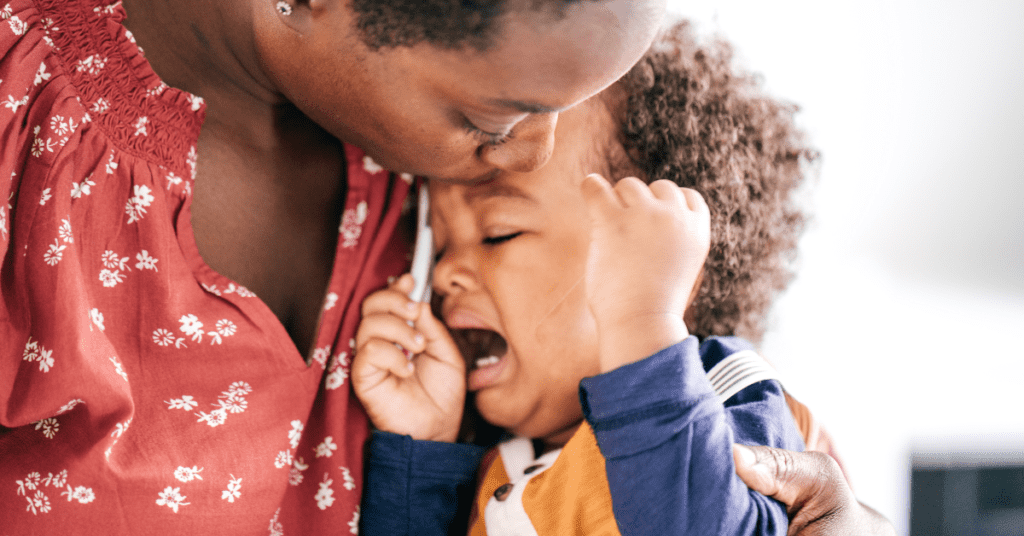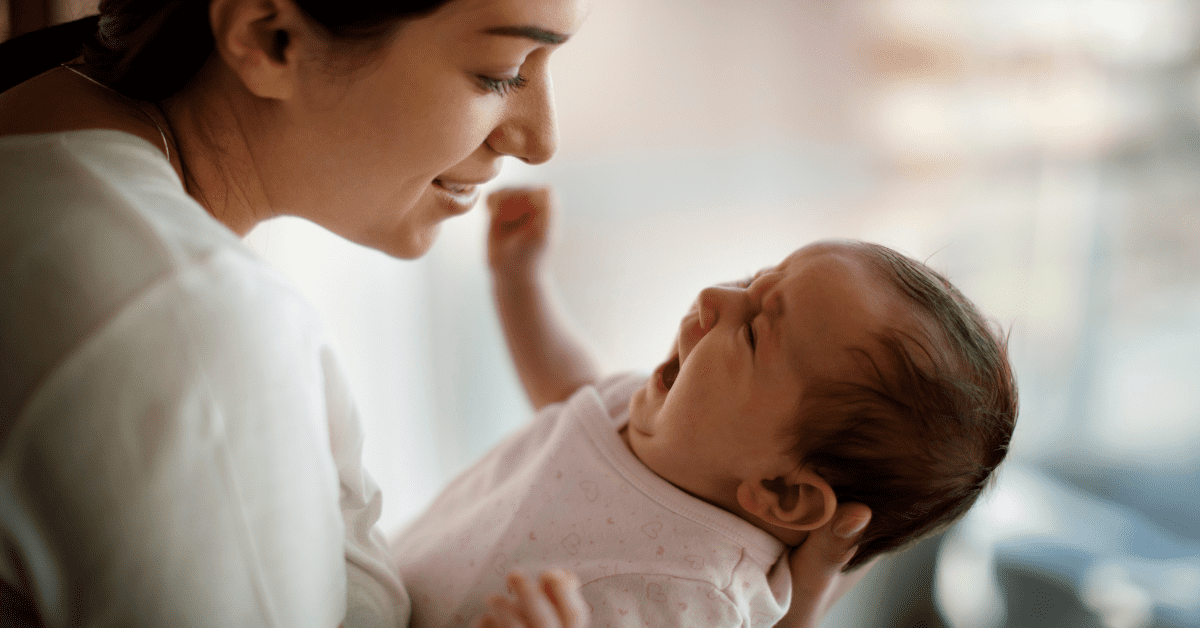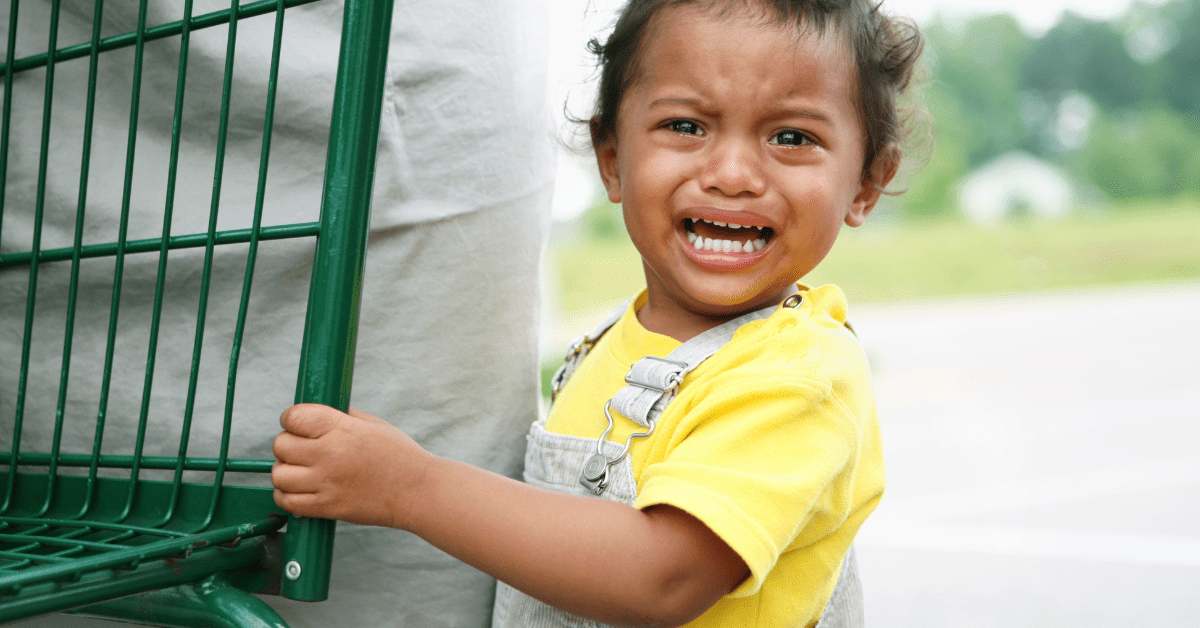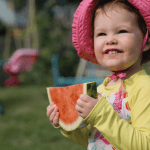For Parents
The Science Behind the Toddler Tantrum and How to React
Our Child Development Expert Sam Wass explains the science behind your toddler’s tantrums to help you better understand how to navigate them.


I don’t know of a single parent who hasn’t got stories about the time their toddler had a total meltdown for reasons that, to us, seem completely dotty. Whether it’s my son, Freddie, crying because his baby sister is looking out of his window in the car, instead of the window on her side, or out of frustration because the imaginary window on his imaginary fire truck won’t open, or because you – ridiculously and selfishly! – won’t let him pour apple juice on the cat. We all have stories like this and laughing about them with other parents is a big part of what helps us to stay sane.
What are tantrums?
Tantrums are something that develops in almost all children between the ages of 1 and 5. According to one study, that defined tantrums as any episode in which a child became violent, self-injurious, destructive, or verbally or physically aggressive, 85% of 3-5-year olds tantrum regularly, of whom 8% tantrum daily.
But this varies a lot between children, from a quick burst of grumpiness and shouting that comes and goes out of nowhere, to angry outbursts or temper tantrums that can build and last for hours with biting, scratching, and total destruction of everything around them, ending only when the child hits exhaustion.
Why are toddler's tantrums stressful?
There are lots of reasons why your child’s tantrums can be stressful. Of course, all parents are used to hearing their children cry as babies. But what makes toddler tantrums so distressing is that suddenly it feels that it’s directed at you.


When babies cry, there’s generally a reason, such as being colicky, teething, or tired. But when toddlers cry, it often suddenly starts to feel as if you’re the reason. Suddenly, things have changed from ‘life’s tough but mummy and daddy are helping me through it’ to ‘life’s tough because mummy and daddy are making it that way’.
Because of this, many parents say that they are more likely to mirror their child’s behavior and lose their temper too. Even though we all know this doesn’t help the situation, virtually every parent I’ve talked to can see that shouting during a child’s tantrum doesn’t help them to calm down, but it’s nearly impossible not to do sometimes.
This can make you feel horribly guilty afterwards, especially as temper tantrums always seem to come when you’re out and about, in a hurry or when you’re least able to feel sympathetic and supportive.
Does a child's age affect their tantrums?
Interestingly, evidence shows that babies who cry more at night at 6 months old are more likely to have tantrums than older children. So even though it can feel as if those toddler temper tantrums are your fault, they almost certainly aren’t. Some children just simply get stuck in negative moods more easily than others during their early child development, but most grow out of it.
The reason tantrums feel so different is that, between the ages of 6 months and 2-3 years, your child has learned to want things. A typical 8-month-old will be receptive and responsive when you initiate things, for example, when you smile at them, they’ll smile back. But generally, they won’t try to get you to smile at them until a few months later at about 12 months. From there, though, everything spirals!
They often start just by wanting you to smile at them, but from there it transitions to suddenly wanting everything, from trying to climb into the neighbour’s car, to insisting that they wear two hats in bed!


What makes this doubly frustrating is that this phase of suddenly wanting things often comes before the ability to communicate properly, so they know what they want, but they can’t say it. And what makes it trebly frustrating is that children at this stage can forget that, in order for you to know what it is that they want, they have to tell you!
Children tend to assume that, if they know what they want, then you must, too. The ability to understand that not everybody knows what you know tends to emerge in older children. Toddlers tend to assume that the only reason that you’re not giving them what you want is that you’re being difficult, which often results in temper tantrums.
The science behind toddler tantrums
From books about tantrums for parents to books about tantrums for children, to Instagram and Tiktok accounts, there’s a massive amount of support available out there. It’s relatively easy to find support from parents and childcare professionals sharing what has been helpful for them when dealing with toddler tantrums.
But in terms of actual science and looking at what it is about children’s brain development that causes tantrums and understanding why some children tend to have more frequent, angry outbursts than others, there’s actually little scientific research. And it’s not surprising, if you think it’s tricky to get your fussy toddler to sit still for long enough to be strapped into a car seat, then you should try (as we have in my lab) getting them to stay calm and sit still for long enough to have their brain activity measured!


We do, however, know some things from studies that look at children's brain development while they’re asleep. This can give us some clues about what it is about toddler’s brain development that causes them to have tantrums.
We know, for example, that the parts of the brain which process basic survival mechanisms (like the control of breathing and heart rate) are the first parts of the brain to become functionally active, and that the parts of the brain that are thought responsible for processing emotions develop before other areas involved in planning and vocal communication. But we don’t know anything, really, about tantrum triggers in toddlers or what’s happening in a child’s brain while the tantrums happen. And, although any parent could readily tell you that children are more likely to tantrum when they’re tired, we also don’t know very much about why this is. We don’t understand how tiredness affects a child’s brain, and why this affects their emotional ups and downs.
We do, however, know some things from studies that look at children’s brain development while they’re asleep. This can give us some clues about what it is about toddler’s brain development that causes them to have tantrums.
Home environment
Firstly, we can look at how different children experience different types of environments at home, and try to understand what it is about children’s these environments that might trigger tantrums.
Children's interactions
Secondly, we look at how children’s interactions with the world change depending on their own stress levels – for example, whether children try to calm themselves down when they’re stressed, and what happens when these behaviours go wrong.
Adult interactions
Finally, we can look at how caregivers and their teachers react when children start to throw a tantrum – and how different types of reactions affect how long a tantrum lasts.
Children use their environment to help calm themselves down – sometimes! This positive behavior is called self-regulation which in many ways is the opposite of tantrums.
Even a newborn will tend to close their eyes when there’s too much going on around them. This is a protective, self-regulation mechanism, that helps them stay calm. Other behaviours include self-soothing touching, looking away or seeking comfort from others to regulate their moods.
But that’s not all. Optimal learning happens at the mid-point between over-stressed (running around, bouncing off the walls) and under-stressed (lying, dozing, about to fall asleep). When children are under-stimulated, they change their behaviours to upregulate their stress, too. For example, young children often sing to themselves for some excitement when things are quiet. And my 3-year-old, who still (despite our best efforts!) likes to chew on his baby sister’s leg from time to time, does it noticeably more often when he’s bored. When children are used to being in mildly stressful situations and then suddenly find themselves in a situation that’s ‘too calm’, they’ll try to engineer a way to increase the excitement levels, somehow.


Even from early on, most children can use their own behaviours to help manage their feelings and moods. When they’re over-excited they reduce stimulation – by closing their eyes, or by self-soothing, or reaching out to others. And when they’re under-excited, they can compensate to make things more exciting.
But what we also see, particularly during early development, are the exact opposite types of behaviour. Where, instead of doing behaviours that correct changes in our mood, to help maintain an even keel, they instead do the opposite types of behaviours that accentuate changes in their mood. Tantrums are the perfect example of this.
My research, and those of others, has looked at how specific behaviours during a tantrum can be triggered in response to increases in stress, but then they go on to have the knock-on effect of increasing a child’s stress levels even further. Often, what sustains a tantrum can be completely different to what started the tantrum in the first place.
What causes the snowball effect?
There’s one example that I always think about from filming the Secret Lives series. There was one, especially sensitive, 4-year-old boy, who was in a noisy playroom with 11 other 4-year-olds and found it especially hard to cope. Once he’d been in the room for a few minutes, we see him go up to another child and try to snatch his toy from him. Now, this is a child who knows how to share as we’ve seen him explain to other children that ‘sharing is caring,’ but at this moment, as a consequence of the noisy environment, his stress levels are high making him less in control of his behaviour.
This triggers a wrestling match which increases stress levels even more. He wins, making his friend burst into tears, which, again increases those stress levels. This results in him being told off publicly by the teacher (which he hates – he is a sensitive boy, aware of his status in the group) and being publicly told off sends those stress levels soaring.
Stress changes how we interact with the world, and people around us, and these changes then feed back to us by making us even more stressed. It’s natural, and it’s virtually impossible to avoid. Stress is contagious, so if your child’s highly stressed, this will naturally make you more stressed, and consequently more inflexible in your behaviour. You’ll then end up parenting your child differently to how you normally would, which increases your child’s stress levels still further.


Understanding this is important because it changes parents’ priorities when dealing with tantrums. If your child seems to tantrum at times when you’d least like them to do it (like when you’re out in public), it could be because the very fact of there being lots of people, and lots of noise, is affecting them. This makes them more oppositional and less flexible than they’d normally be. If you respond by becoming oppositional and stricter yourself, which is an entirely natural reaction, then you might unintentionally be making your own life harder, by prolonging how long the tantrum lasts.
Being aware of what can trigger your child’s tantrums is a great way for you to be more aware of your child’s behaviour and can even help you prevent tantrums before they happen. Here are my practical evidence-based tips:
Be aware of the environment
Children can be very sensitive to being in different environments. Whether you’re grocery shopping or out at a museum, we know that noise increases stress in children – and that this is particularly true for loud echoey spaces with lots of people talking. Just being around that noise can lead to increases in stress levels which can impact how your child interacts with you.
In addition, most children find structure and predictability relaxing, and lack of structure stressful. Another reason why shopping trips can tend to trigger tantrums is that shopping is an intrinsically unstructured environment. Physically, there are lots of open spaces, they’re getting dragged around from place to place, and children never know how long it’s going to last. This lack of structure, combined with the noise and having so many people around, make it a super stressful experience for children. And again, your child being more stressed will change how they interact with you.
Look for early warning signs


If your child's tantrums tend to be particularly long-lasting and severe, you can often see the stress levels building up before the tantrum kicks off. If you’re in the type of overstimulating environment described above, it’s helpful to try to watch for the warning signs. These include a child starting to move faster, or losing some of their fine motor skills (e.g. becoming more likely to knock things). Some children have particular facial expressions that they do when they’re building up to a tantrum.
For children who’re especially non-communicative (e.g. non-verbal children with Autism), some monitors exist to track a child’s bodily stress levels so that you can tell when a melt-down is about to happen before it starts.
Change their environment
When you see the tantrum warning signals, then you need to react fast. Research suggests that, once you get beyond a certain level of intensity in a tantrum, it doesn’t actually matter too much what you do and using different behaviour management techniques doesn’t really affect how long the tantrum lasts. But if you catch it early enough, when the tantrum is still building, then what you do does make a difference. And by far the most effective technique is to drop what you were doing and go and do something else. Change room, to change mood. And if they’re hungry or thirsty then feed them, right away.
Distract, don’t try to reason


Lots of parents view tantrums as an opportunity to teach their child some reason. So, if their child insists that they should be allowed to wear two hats to bed, then the parent very patiently, and logically, explains that this would make their head hot, and that there’s only room for one hat on their head at a time anyway. But almost all behaviour management experts agree, now, that this really isn’t the time to try to teach logical reasoning to your child. (The times when we learn are when we’re calm, and relaxed – not when we’re feeling stressed.)
In my family, we go for exactly the opposite approach. Following advice from Harvey Karp, we try actively and energetically to agree with what my toddler wants, even going so far as to match their intonation and phrasing. (‘Yes! You want two hats! Two hats on now!’) Then, once the feeling of being understood has helped him relax, we try to move the focus of his attention away from the particular thing onto something else. We try to do this energetically and excitedly, because it’s easier to shift from being negatively excited about something to be positive excited about something else, than it is to shift from being negatively excited something to being calm.
To conclude...
Every parent will, of course, have their own findings for what works and what doesn’t. But all will agree that dealing with toddler temper tantrums is tough and exhausting.
For me, focusing on identifying early warning signs, and what I can do early on in a tantrum to stop it from developing further, works best. It helps us keep as sane as we can be with two under 4-year-olds in the house! And, so far, it means that we’ve managed to avoid washing the cat in apple juice.


Sam Wass
Child Development Expert
Latest Posts


Innovative Outdoor Learning Activities for Early Years


Effective Communication Strategies for Parents and Early Years Educators


The Link between Play and Cognitive Development According to Research


Nurturing Healthy Eating Habits in Young Children – A PE Specialist’s Approach


What Every Parent Needs to Know about Dietary Needs for Kids Under 5









